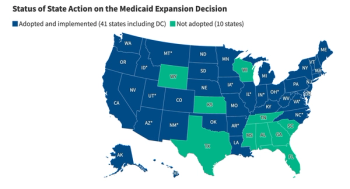
Empowering the Next Generation of Nurse Leaders
Healthcare organizations must encourage anyone in need to explore the mental health and wellness resources available at their institution.
As nursing makes up the largest portion of the healthcare workforce, it is important to foster an environment where nurses and nursing leaders are put in a position to positively impact the future of health care and steer the industry’s evolution to holistic care models, where it moves beyond treating a condition.
As we enter year three of the pandemic, we’ve seen the definition of holistic care be tested, challenged, and also enhance this method of caring, ultimately improving the quality of patient care.
It is during these times that healthcare organizations must support the workforce striving for nursing excellence, especially during turbulent times to allow them to perform at their best at the point of care.
Fostering the right environment
Regardless of the field of healthcare, both patients and the workforce are dealing with many new psychosocial elements that impact their well-being. The pandemic has brought on many personal and professional stresses that contribute to periods of emotional exhaustion, anxiety, depression and other mental health concerns.
Care goes beyond the “healing” or “fixing” of an injury or ailment.It extends well into “treatment” in which providers must be able to offer emotional and mental care as well.
Mental health remains an area that has been heavily impacted during the pandemic, and it has put a severe strain on resources. There is value in aligning both the clinician and operations side of healthcare to create the right environment for nurses.
To achieve this, organizations can build an inclusive environment where staff feel that they can bring their full selves to work for the betterment of patients and families. Examples include holding focus groups to connect and share experiences and welcoming open conversations around tough challenges that people are facing.
Creating a healthy environment for both patients and staff is of the utmost importance. Organizations must encourage anyone in need to explore the mental health and wellness resources available at their institution.
At Stanford Children’s Health, we make it practice that if you see someone who is struggling, check in with them, offer support and let them know you care. With the right environment, staff are supportive of each other’s needs and feel comfortable offering a helping hand.
Ongoing education and workplace development
As the healthcare environment changes, so must our approach to learning and development. Hospitals and health care systems must focus on all care elements, from building resilience to supporting well-being to communicating during trauma. As an industry, we need to continue to provide resources for leaders and staff to develop stronger skills to meet new demand.
In March, Stanford Children’s Health brought in a national speaker to discuss ways that we could address these concerns for our patients, and how conversations change when we focus on resilience and overall wellbeing (for both the patient and ourselves).
This nontraditional form of development led to engaged conversation and actionable steps that could be brought to the bedside. Investing this time in guiding the next generation of nurse leaders is one way to drive meaningful progression.
Opening doors to innovate
Nurses can also feel empowered and that their voices are important and influential through innovating at the bedside. It is through nursing innovation where ideas turn into tangible solutions to solve for pressing patient demands.
Nurses see the patient at the bedside and how they react to stimuli in real time. It is at that window of time that nurses can then share ideas on how to overcome challenges or improve experiences based on these interactions.
Healthcare institutions can support this movement in a couple of ways. First, by getting the word out to their nursing staff that there is an avenue to share ideas and innovations without fear, and second by providing nurses the opportunity to translate and transfer ideas that can positively impact more patients through encouragement, support, and mentorship.
The right environment, education and development, and support to innovate are critically important drivers of successful care programs, and all provide avenues for nursing to positively impact the future of health care.
Jesus Cepero, Ph.D., RN, NEA-BC, is chief nursing officer at
Newsletter
Get the latest industry news, event updates, and more from Managed healthcare Executive.





















































